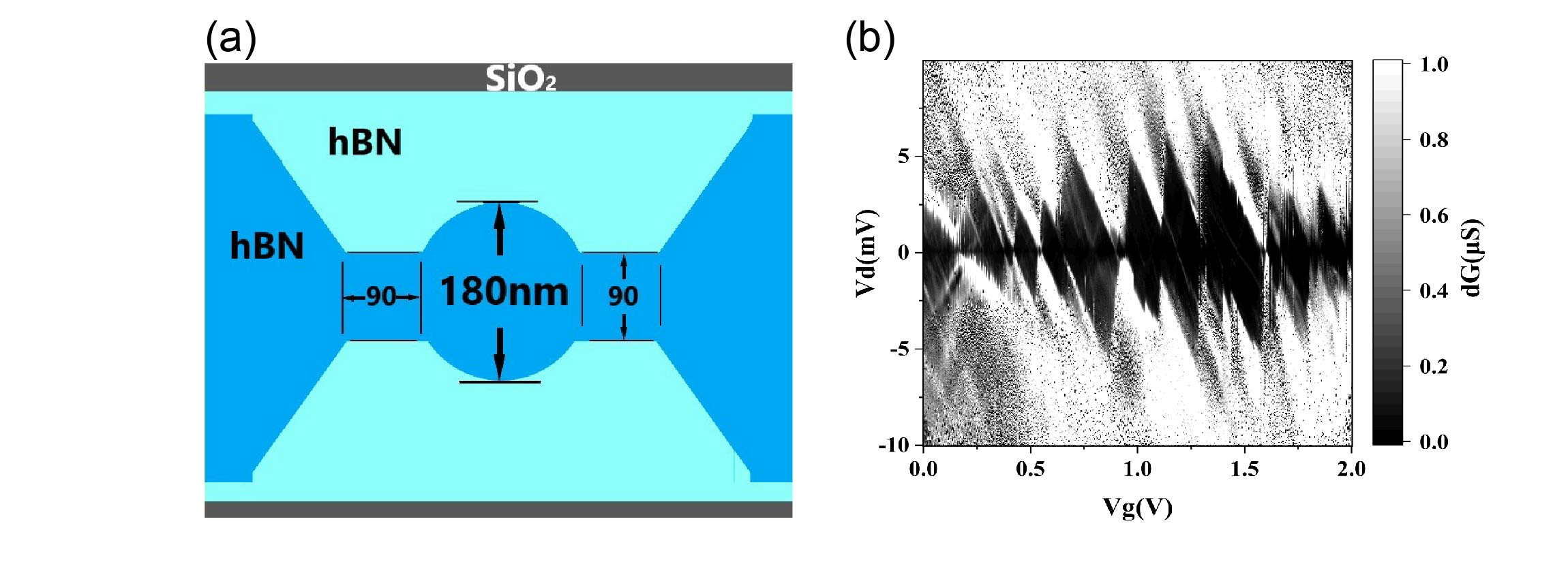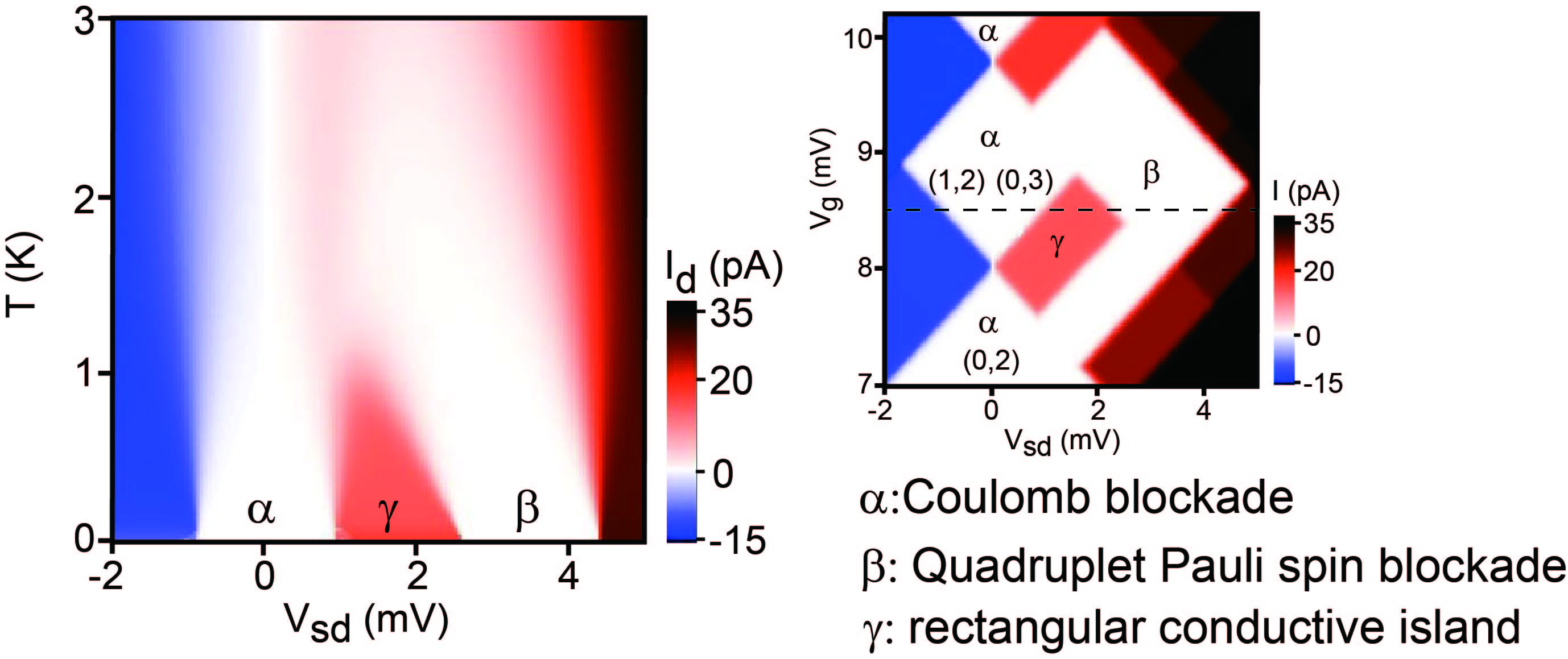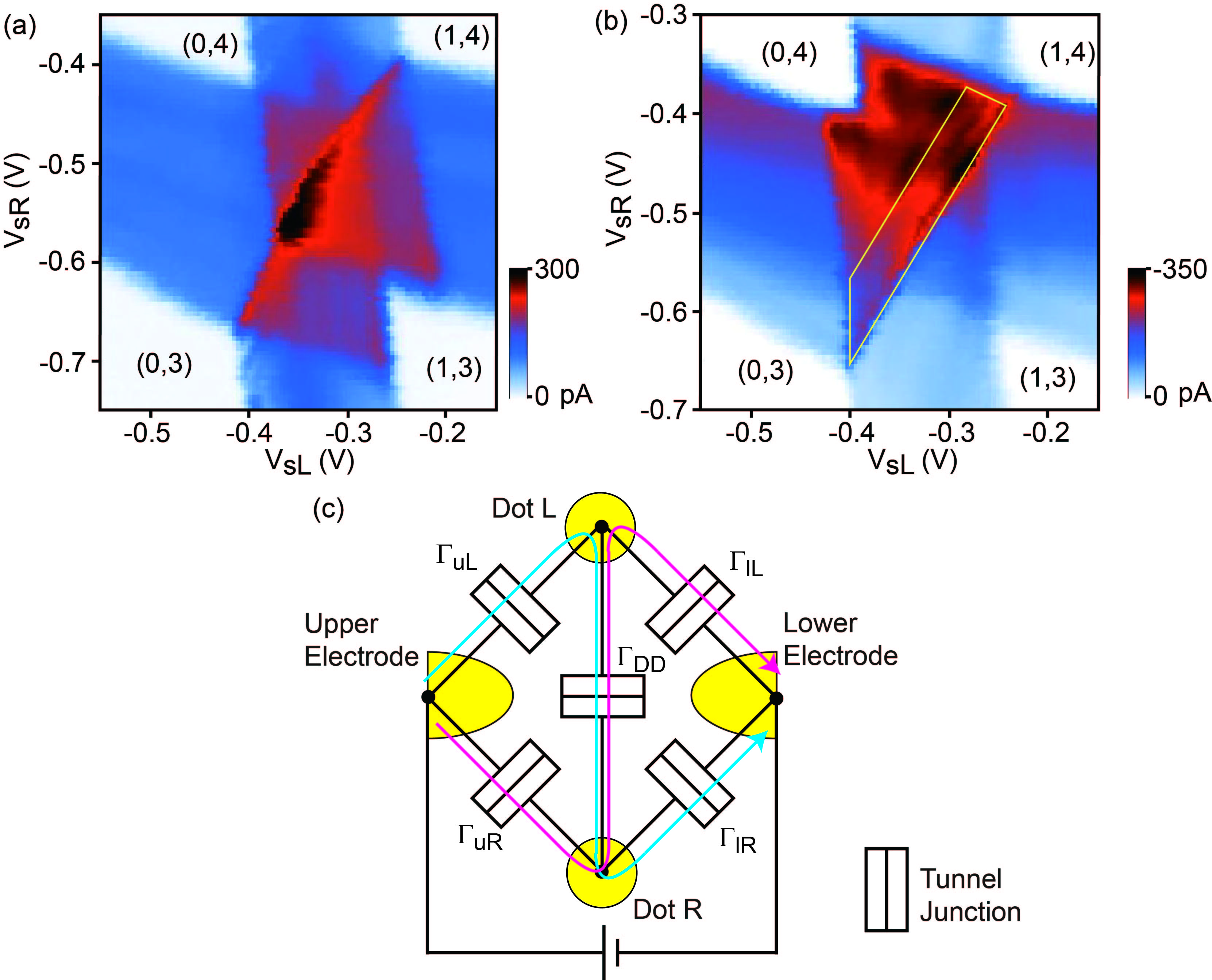
1. Research for Novel Devices with multilayer graphene
We report on low temperature carrier transport property of quantum dot (QD) devices based on hexagonal boron nitride-encapsulated tetralayer graphene heterostructures. In the device with single dot geometry, we demonstrate a stochastic Coulomb blockade, suggesting formation of multiple dots coupled each other in series/parallel. Under a perpendicular magnetic field, the overlapping Coulomb diamonds are lifted at zero bias voltage and the charging energy is decreased. These imply the suppression of multiple dots behavior. Our results pave a way toward the investigation of interlayer correlation on single electron transport in few-layer graphene QDs.

Fig. 1 Upper panel of quantum dot. (b)differential conductance as a function of Vg and Vd.
2. Research for Novel Devices with Self Assembled Molecules
Until now, nanoscale electronic devices have been fabricated by top-down methods using a photolithography and an electron beam lithography. However, it is very difficult to fabricate the devices with a size of 10 nm or less, which is expected to have a quantum mechanical effect, and errors will occur in the fabrication process. This process variability is a big problem when devices are integrated on a large scale, even if it is small for one device. On the other hand, the bottom-up methods using fullerenes, carbon nanotubes, colloidal quantum dots, etc., which utilizes the self-assembling of substances, has the potential to reduce the device size to 10 nm or less and control the process variability. therefore, we try to fabricate such bottom-up nanodevices.


Fig. 2 Carbon nanotube tansistors with nanogap and their transport properties.
3. Research for Transport Properties of Vertical Quantum Dots (Artificial Molecules)
We use a hybrid vertical-lateral double dot device consisting of laterally coupled vertical quantum dots to measure the inter-dot tunnel coupling. Using non-linear transport measurements of “Coulomb diamonds” we show that an inherent asymmetry in the capacitances of the component dots influences the diamond slopes thereby allowing determination of the dot through which the electron has passed. We use this technique to prepare a delocalized one-electron state and Heitler-London two-electron state, and show that the inter-dot tunnel coupling, which determines whether HL is the ground state, is tunable. This implies the relevance of our device for implementing two-electron spin entanglement.
T. Hatano,
M. Stopa, and S. Tarucha, ‘Single-electron
delocalization in hybrid vertical-lateral double quantum dots’, Science
309, 268 (2005).


Fig. 3 Transition of electron waves between two dots in Parallel Coupled Vertical Quantum dots (Science,2005).
4. Thermally assisted Pauli spin blockade in double quantum dots
We investigate the influence of thermal energy on the current flow
and electron spin states in double quantum dots in series. The quadruplet
Pauli spin blockade, which is caused by the quadruplet and doublet states,
occurs at low temperatures affecting the transport properties. As the
temperature increases, the quadruplet Pauli spin blockade occurs as a result of
the thermal energy, even in regions where it does not occur at low
temperatures. This is because the triplet state is formed in one dot as a
result of the gradual change of the Fermi distribution function of the
electrodes with increasing temperature. Moreover, the thermally assisted Pauli
spin blockade
results in coexistence of the Coulomb and Pauli spin blockades.
Conversely, for the standard triplet Pauli spin blockade, which occurs as a
result of the triplet and singlet states, the current through the double dots
monotonously smears out as the temperature increases. Therefore, the thermally
assisted Pauli spin blockade is not clearly observed. However, the coexistence
of the Coulomb and triplet Pauli spin blockades as a result of the thermal
energy is clearly obtained in the calculation of the probability of the spin
state in the double dots.
M. Kondo, S.Miyota, W. Izimida, S. Amaha and T.Hatano, ‘Thermally assisted Pauli spin blockade in double quantum dots’, Physical Review B 103, 155414 (2021).

Fig. 4 Scematics of Quadruplet Pauli Spin Blockade

Fig.5 Temperatue Dependence of Quadruplet Pauli Spin Blockade
5. Coexistence of parallel and series current paths in parallel-coupled double quantum dots in nonlinear transport regime
We investigated the electron transport properties of parallel-coupled double quantum dot (DQD) devices under magnetic fields. When a low magnetic field was applied, electron tunneling through parallel-coupled DQDs was observed. Under a high magnetic field, we observed both electron tunneling through parallel- and series-coupled DQDs under nonlinear transport conditions. In addition, the Pauli spin blockade was observed, indicating tunneling through the series-coupled DQDs. We attribute these behaviors to the magnetic-field-induced changes in the tunnelcouplings that allow the coexistence of the current paths of the parallel and series configurations. The electric circuit of the parallel-coupled DQDs in Fig. 4(c) is equivalent to a classical bridge circuit. Therefore, parallel-coupled DQDs, in which all tunnel couplings are sequential processes, can be considered as quantum bridge circuits.
T. Hatano, T. Kubo, S. Amaha,
S. Teraoka, Y. Tokura, and S.
Tarucha, ‘Coexistence of parallel and series current paths in
parallel-coupled double quantum dots in nonlinear transport regime’,
Applied Physics
Express
14,
105001 (2021).
.jpg)
Fig.6 (a) Stability diagram at Vc = − 0.7 V, Vb = − 0.5 mV, and B = 12 T. (b) Stability diagram at Vc = − 0.7 V, Vb = −20 μV, and B = 12 T.

Fig.7 Stability diagrams at B = 12 T, Vc = − 0.7 V, (a) Vb = 0.8 mV and (b) Vb = − 0.8 mV. (c) Electronic circuit of the parallel-coupled DQD device. When the interdot tunnel coupling is sequential, the current flows in the direction of the light blue or red arrows. The two yellow circles and the two yellow semiellipsoids indicate the positions of the two QDs and two electrodes, respectively.